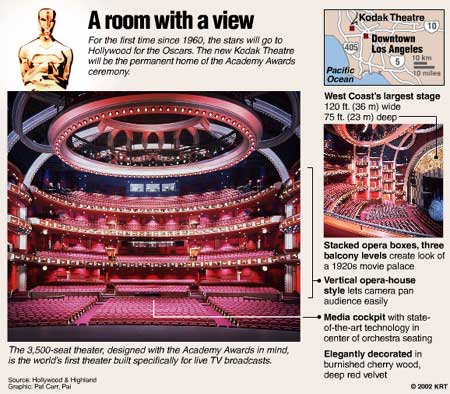
|
Marketing
Oscar: “I’m a gun for hire,” said the voice on the telephone. “The studio hires me to reach as many academy members as possible. And because I’ve been doing this for 20 years, I have a pretty complete list of who those academy members are.” The speaker, a shadowy operative known as an Oscar campaign consultant, emphasizes that he (or she) is talking to a reporter only on condition of anonymity. Every year at this time this consultant is busy buying ads, mailing videos and thinking up stunts aimed exclusively at the 5,700 voting members of the Academy of Motion Picture Arts and Sciences. The goal is to convince these Oscar voters that certain films and individuals are worthy of a gold statuette. It’s a mission that unfolds under the radar of most movie fans, a war waged in the trade papers and in private screening rooms. At stake are careers, bragging rights and the millions of dollars that can be generated by an Oscar win. The price tag: millions. Maybe tens of millions. Maybe more. Some Hollywood insiders believe the industry is spending more this year than ever before. All the feverish campaigning culminated Tuesday, the last day on which the accounting firm of Price Waterhouse would accept Oscar ballots from the academy membership. Then everyone holds a collective breath until the results are announced at the annual Academy Awards telecast March 24. The first problem faced in the Oscar war is knowing your target. That’s because the academy refuses to release the names of its members. A good Oscar campaign consultant (and most studio publicity departments) maintain their own rosters, the result of years of networking, personal relationships, a bit of common sense and even some guessing. For example, everyone nominated for an Oscar is also offered membership in the academy. Most academy members, though, get in because the membership committee recognizes their body of work. Since there’s no formal announcement of new members, the consultants and studio publicists place ads in Variety and The Hollywood Reporter asking academy members to contact them. Once a person has been identified as an academy member, studios and consultants will stay in touch. Each year that person will receive cards — often one from each studio and several from private consultants — to mail back with their most recent address. Each September the studios begin looking over that year’s releases, looking for performances and films worthy of an Oscar push. Because of the costs involved a studio can’t mount a campaign for each of its films. The idea is to put the available resources behind films with a real chance of winning. Sometimes, though, an ad will appear in the trades touting the Oscar-worthiness of a movie that just about everybody agrees was a dog. Usually this means the studio is stroking the ego of an actor, director or producer. “For your consideration” ads, as much a tradition as “I want to thank my agent” acceptance speeches, begin running in Variety and The Hollywood Reporter, the twin show-business bibles, as early as November. The object is to sway the voters who will decide the Oscar nominations that will be announced in February. And nominations are decided by voters in distinct professions: Actors nominate actors, directors nominate directors and so on. But these ads, which often feature glowing quotes from movie critics, address constituencies beyond the academy members. They keep films and performances fresh in the minds of other voters — members of the press, critics’ groups and actors and directors who may not be members of the academy but who determine the nominations in other contests: the Golden Globes, the Screen Actors Guild and the Directors Guild, among others. There’s a ripple effect, since a win at the Golden Globe, SAG and DGA awards is believed to influence Oscar voters. “At this
point you’re addressing everybody,” said a veteran Oscar
campaigner. “Basically you’re telling Oscar voters, ‘Look
at all the people who have acknowledged this person’s work.’
These ads remind voters of movies and performances they might have
forgotten.” This year Jennifer Connelly (”A Beautiful Mind”) was nominated for Best Supporting Actress while Sissy Spacek (“In the Bedroom”) was nominated for Best Actress, even though they had almost exactly the same amount of screen time in their respective films. Why the discrepancy? Because in their “for your consideration” ads DreamWorks suggested that Connelly be nominated for a supporting performance, while in its ads Miramax suggested that Spacek’s was a leading role. The goal of any Oscar campaign is to get the academy members to see the movie. Throughout the year the academy holds free screenings of that year’s films. But knowing that the official screenings reach only a limited number of Oscar voters, campaign planners set up their own viewings and send out invitations. And not just in Los Angeles. Wherever academy members tend to congregate — New York, London, Palm Springs, Santa Fe, Aspen — theaters are rented so that movies with Oscar potential can be seen by the voters. For much of its history, the academy has had to deal with many of its members not seeing all the nominated films before casting their ballots. Members with active careers often are too busy making movies to actually go see them; older members of the academy are often confined to their homes or unwilling to deal with the hassle of an evening out. Beginning in the early ‘90s the studios tried to get around this by manufacturing video tapes of their Oscar-worthy films and sending them to academy members. Miramax Films is cited by most insiders as the first studio to do this on a regular basis, which may in part account for the studio’s success in picking up nominations for its non-mainstream movies. (By the mid-1990s things were starting to get out of hand, with some studios sending out screeners as part of lavish gift baskets. The academy, fearing that this was a bit too close to open bribery, decreed that screeners must be in an undecorated cases and mailed without accompanying merchandise.) Things heat up once the nominations are announced in early February. Variety and The Hollywood Reporter respond by increasing their advertising rates 10 percent in anticipation of a windfall of Oscar advertising. During Oscar season an ad on the cover of The Reporter costs $25,000, about $2,200 more than usual. A cover ad in Daily Variety costs $41,310; the cover of Weekly Variety goes for $44,150. Despite those stiff prices, prime advertising spots in those publications are in such demand that the two periodicals hold lotteries to ensure fairness in allocating the most desirable ad space. “Providing you’ve got the budget, you buy every premium ad location you can,” one insider said. “Usually you go for full color ads, since they attract more attention.” The academy bans Oscar nominees from overtly campaigning for votes, but some — especially underdogs — often go looking for additional publicity. In the days following the nomination announcement journalists are inundated with offers to interview actors who have made the cut. The hope is that when these interviews are published, they'll be read by academy members whose votes will be swayed. In recent years Oscar campaigners have turned to advertising on billboards on busy Los Angeles streets. And sometimes studios will resort to old-fashioned publicity stunts, as was the case last week when the makers of “Moulin Rouge” not only bought a billboard over Sunset Boulevard, but also hired dancers in cancan costumes to put on a rooftop show high above the street. Sometimes fate steps in. The campaign for Denzel Washington, nominated as Best Actor for “Training Day,” got an unexpected bump Feb. 25, when Newsweek ran a glowing profile of the actor. Julia Roberts was quoted in the magazine as saying: “I cannot absorb living in a world where I have an Oscar for Best Actress and Denzel doesn’t have one for Best Actor.” An accompanying story examined how African-Americans are usually slighted at Oscar time. And finally, as in any campaign, allegations of dirty tricks arise. In December DreamWorks accused Miramax staffers of phoning journalists to point out that DreamWorks’ “A Beautiful Mind” takes some major liberties with the facts of the life of mathematician John Forbes Nash. More recently there was grumbling that Warner Bros. was “playing the race card” after the publication of Newsweek’s Washington profile. All of which one Hollywood insider finds amusing but basically irrelevant: “There’s always lots of talk about spending and campaign tactics. But mostly it’s all geared to getting the Oscar voters to see the movies. People tend to forget that in the end, it all comes down to the quality of the movie.” |
|||
|
TCU Daily Skiff © 2002 |
||||


